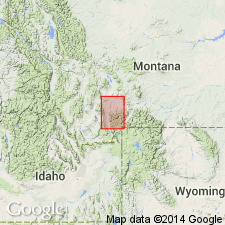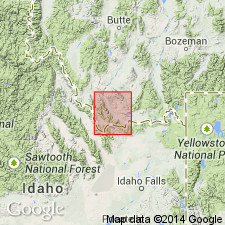
- Usage in publication:
-
- Cherry Creek formation*
- Cherry Creek beds*
- Modifications:
-
- Original reference
- Dominant lithology:
-
- Marble
- Limestone
- Schist
- Gneiss
- AAPG geologic province:
-
- Northern Rocky Mountain region
Summary:
Cherry Creek formation; Cherry Creek beds. [Cherry Creek group adopted by the USGS (ca. 1938).] Recognized in central southern Montana (Three Forks quadrangle) and southwestern Montana. Interlaminated gneiss, mica schist, marbles, crystalline limestone and quartzite, all highly inclined and perfectly conformable with one another. Thickness 7,000+ feet. Unconformably underlies Belt formation and rests on Archean gneiss and schist. Occupies area of 30 to 40 sq mi in foothills west of Madison River. A limited area of these beds occurs on east side of Madison Valley at western edge of Madison Range. Between Cherry Creek [southwest corner of Three Forks quadrangle] and Wigwam Creek, on west side of Madison Valley the upturned edges of this group are overlain by unchanged Cambrian beds. [Age is Precambrian (Algonkian and Archean).]
[GNC remark (ca. 1938, US geologic names lexicon, USGS Bull. 896, p. 416): According to J.T. Pardee (personal commun.) the rocks named Cherry Creek by Peale do not resemble the Belt series but do very closely resemble the rocks mapped by Peale as "Archean."]
Source: US geologic names lexicon (USGS Bull. 896, p. 416).

- Usage in publication:
-
- [Cherry Creek series]
- Modifications:
-
- Revised
- AAPG geologic province:
-
- Northern Rocky Mountain region
Summary:
Pg. 1329. Cut by Blacktail granite gneiss (new).
Source: US geologic names lexicon (USGS Bull. 1200, p. 748-749).

- Usage in publication:
-
- Cherry Creek series
- Modifications:
-
- Revised
- AAPG geologic province:
-
- Northern Rocky Mountain region
Summary:
Pg. 2-3. Cherry Creek series includes Axes Creek phase (new) in area of Axes Creek, Beaverhead County, Montana.
Source: US geologic names lexicon (USGS Bull. 1200, p. 748-749).

- Usage in publication:
-
- Cherry Creek series
- Modifications:
-
- Areal extent
- AAPG geologic province:
-
- Northern Rocky Mountain region
Summary:
Pg. 6-8. Thickness of Cherry Creek series about 30,000 feet in southern end of Ruby Range; contains seven main marble horizons. Younger than Pony series.
Source: US geologic names lexicon (USGS Bull. 1200, p. 748-749).

- Usage in publication:
-
- [Cherry Creek series]
- Modifications:
-
- Revised
- AAPG geologic province:
-
- Northern Rocky Mountain region
Summary:
Pg. 20, 27, 29, 34. South of line connecting Melrose, Whitehall, Three Forks, and Livingston, [Cherry Creek] series underlies Flathead sandstone.
Source: US geologic names lexicon (USGS Bull. 1200, p. 748-749).

- Usage in publication:
-
- Cherry Creek group
- Modifications:
-
- Revised
- AAPG geologic province:
-
- Northern Rocky Mountain region
Summary:
Pg. 350-351, pl. 1. Cherry Creek group. Described and mapped in Lima region, Montana. Intruded by Dillon granite gneiss (term replaces Blacktail granite gneiss, preoccupied). Stratigraphic relations between Pony group and Cherry Creek not clear in this area.
Source: US geologic names lexicon (USGS Bull. 1200, p. 748-749).

- Usage in publication:
-
- Cherry Creek metamorphics
- [Cherry Creek gneiss]
- Modifications:
-
- Revised
- AAPG geologic province:
-
- Northern Rocky Mountain region
Summary:
Pg. 4-7, 14, geol. map. [Cherry Creek] metamorphics and [Cherry Creek gneiss] mapped and described in Tobacco Root Mountains. Within map area, Cherry Creek and Pony metamorphics are separated by a seemingly continuous greenish quartzite layer with only small isoclinal folds present within it. Foliation in Cherry Creek metamorphics appears to be everywhere parallel to that in Pony metamorphics in vicinity of contact. Discordance suggested by Tansley and Schafer (1933, Montana Bur. Mines and Geol. Mem., no. 9) not observed. Most significant structural fact is that Cherry Creek metamorphics dip beneath Pony metamorphics. Unless some kind of large scale structural overturning has occurred, Cherry Creek metamorphics in Tobacco Root Mountains, are older than Pony metamorphics (in range in which their type locality has been defined). This is contrary to generally accepted opinion.
Source: US geologic names lexicon (USGS Bull. 1200, p. 748-749).

- Usage in publication:
-
- Cherry Creek Group*
- Modifications:
-
- Age modified
- AAPG geologic province:
-
- Northern Rocky Mountain region
Summary:
Exposed on east flank of Gravelly Range near Cherry Creek, Madison County, Montana (Northern Rocky Mountain region). Has been recognized in the western part of Ruby Range, some 55 km distant and is structurally separate from Gravelly Range. Rocks assigned to Cherry Creek are thought to be part of the same sequence as those called Pony Group. Evidence shows that Cherry Creek and Pony Groups were affected by dynamothermal metamorphism about 2,750 m.y. ago. Age is considered to be Archean in this report. Previously considered Precambrian.
Source: GNU records (USGS DDS-6; Denver GNULEX).

- Usage in publication:
-
- Cherry Creek Metamorphic Suite*
- Modifications:
-
- Revised
- AAPG geologic province:
-
- Montana folded belt
Summary:
Name applied to the marble-bearing metasedimentary rocks (dolomite, marble, biotite-staurolite-garnet schist, quartzite, and amphibolite) in the southern Madison Range, Madison County, Montana (Montana folded belt province). Individual units within this sequence can be correlated at the southern end of the range. Deposited on some pre-Cherry Creek granulites. The Madison shear zone forms the contact between the Cherry Creek and the pre-Cherry Creek. A major deformational event in the Early Proterozoic probably modified the Archean basement of southwest Montana. Hornblende from a gneiss in the Cherry Creek, 8 km south of the Madison zone, yielded a discordant age spectrum with an age plateau of 2.53 Ga. Muscovite from a schist in the Cherry Creek, also 8 km south of the zone, yielded nearly concordant age spectrum with an age plateau of 2.52 Ga. Difficult to say whether these are regional cooling times or times of cooling to closure after being reset by proximity to intrusion. Primary cooling history for area is Archean (hornblende, biotite) and 2.4 Ga (biotite). After cooling, area was metamorphosed, probably synchronous with thrusting. [Explanation for use of rank term "metamorphic suite" not included.] Report includes geologic map.
Source: GNU records (USGS DDS-6; Denver GNULEX).

- Usage in publication:
-
- Cherry Creek Group
- Modifications:
-
- Not used
- AAPG geologic province:
-
- Northern Rocky Mountain region
Summary:
Strata in Ruby Range, Madison County, Montana (Northern Rocky Mountain region), that were assigned to the Cherry Creek Group in earlier reports are reassigned to the newly named Christensen Ranch Metasedimentary Suite. Correlation of rocks of Ruby Range with those assigned to the Cherry Creek Group in the Gravelly Range 60 miles to the east cannot be established at this time. The two units are rudely equivalent in age (Archean); both contain a thick dolomite marble and banded iron-formation. The two differ in the relative position of the dolomite and of the iron-rich rocks. Marble is thought to be the basal Christensen Ranch unit, whereas the iron-formation is the basal Cherry Creek unit.
Source: GNU records (USGS DDS-6; Denver GNULEX).
For more information, please contact Nancy Stamm, Geologic Names Committee Secretary.
Asterisk (*) indicates published by U.S. Geological Survey authors.
"No current usage" (†) implies that a name has been abandoned or has fallen into disuse. Former usage and, if known, replacement name given in parentheses ( ).
Slash (/) indicates name conflicts with nomenclatural guidelines (CSN, 1933; ACSN, 1961, 1970; NACSN, 1983, 2005, 2021). May be explained within brackets ([ ]).

